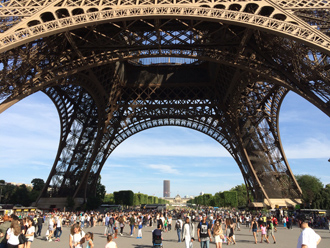| The Eiffel Tower | ||
|
|
The Eiffel Tower is located in Paris in France along the Seine river. It attracts thousands of visitors each year. The Eiffel tower was a symbol welcoming everyone to the grand opening of universal exposition in Paris in 1889, an event which celebrated the Centennial anniversary of French revolution. In preparation for the 1889 Exposition Universelle, the French government held a public contest and invited architects to submit their proposals for the best design. Alexandre-Gustave Eiffel (1832-1923), an architect who had experience as a bridge engineer won the competition, although Emile Nouguier (1840-1898), Maurice Koechlin (1856-1946), and Stephen Sauvestre (1874-1919) did most of the designing work. The construction of the Eiffel tower began in 1887 and finished in two years. The actual height of Eiffel tower is 300 meters. It is made up of 18,000 wrought iron metal parts, and weighs 7,000 tons. Its base is supported by four piers, which are angled to offer efficient wind resistance, and Eiffel added decorative monumental arches connecting the base piers to make the tower more aesthetically pleasing. At three levels there are platforms to allow visitors to view Paris from a dizzying height. Cast iron and wrought iron framing had become popular in the 19th Century, and many bridges, glass houses, railway stations, and early skyscrapers were built with iron frames or lattices. The Eiffel Tower was a spectacular innovation that demonstrated what could be accomplished with this relatively new method of construction. At the same 1889 world’s fair in Paris another spectacular example of iron construction was the Hall of Machines (Galerie des Machines), which rose 43 meters high and covered a space that extended 420 meters by 110 meters. A few decades later, in the early 20th Century, steel frame or lattice construction began to replace wrought iron, but it was until 1930-1931 that any structure surpassed the Eiffel Tower in height (The Chrysler Building and the Empire State Building surpassed the Eiffel Tower). The Eiffel Tower also represents a new taste or consideration of beauty in architecture. For its time, the Eiffel tower was an avant-garde building which worried some people. This iron lattice style of construction contradicted the prevailing opinions about elegance and refinement in French culture. Despite this, the tower attracted large crowds of visitors and brought in tourists whose spending helped the French economy. Nearly two million tourists came to see the Eiffel Tower during the world fair in 1889. The French government recovered its costs of spending and constructing the tower from the first year of ticket sales income. Critics protested the tower and said it was an architectural disgrace, and these critics wanted the tower to be torn down. In fact, the original plan assumed the Eiffel Tower would be disassembled in 1909. However, by that time, the invention of the radio gave the tower a very useful function for radio station and military communication purposes. The tourist trade was also an advantage. Therefore the French government kept the tower standing, and it became a symbol of Paris and France.
|
 Base Piers of Eiffel Tower |
||
Links about The Eiffel Tower:
|
| Back to the World History Timeline in English | ||
Back to the Historylines home page. Articles of French history:Paris Opera house, Louvre, Versailles, Notre-Dame de Paris Articles of Chinese history: oil well, abacus, compass, gunpowder, first dictionary, paper money, wheelbarrow |
Photo Gallery of the Eiffel Tower. Photographs by Virginia Ives, Paul Orsay, and Victor Ives. |
|